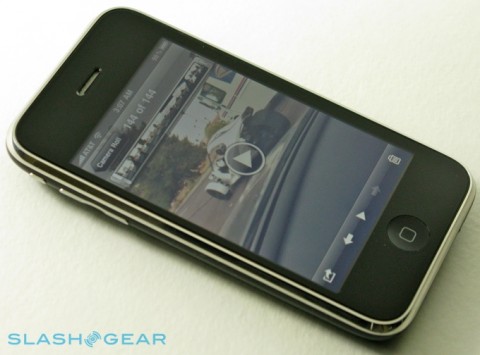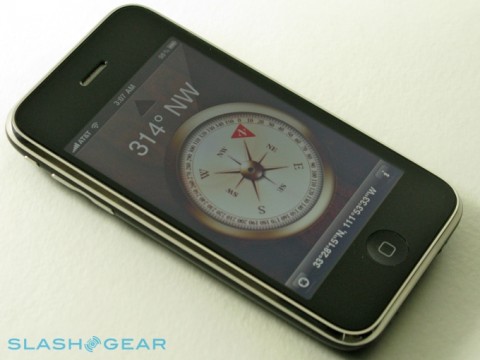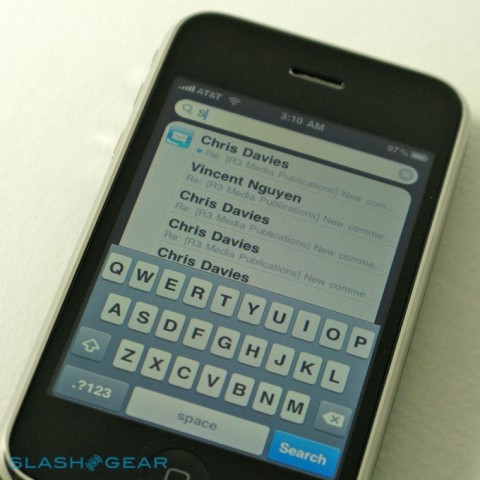Take a guess of how many units can be sold in first 3 days? One millioin is the word out, YES ONE MILLION. With over one million iPhone 3GS units sold in the first three days, there’s no shortage of opinion as to Apple’s successes in their latest smartphone. We’ve covered the basics in our hands-on first-impressions piece; with a few more days of intensive use under our belt, has the iPhone 3GS proved its worth? Slashgear took the initiative of reviewing the iPhone 3GS. Following is taken from thier website and all the credit goes to them. Thanks. The iPhone 3GS’ striking physical similarity to the last-gen 3G came as a mild disappointment back at the WWDC, but we’ve come to appreciate the stability. It underscores the evolutionary, rather than revolutionary, nature of this update and, perhaps more importantly, it means accessories acquired for the iPhone 3G will still have a place with the new 3GS. For a device introduced halfway through the contract agreement of its predecessor, that sort of continuity was pretty much necessary if there was to be any hope encouraging existing owners to upgrade. We do wish that Apple had been a little more imaginative with the finish, however; a matte coating, perhaps slightly rubberized, would differentiate the new handset while not demanding reinvestment in car-kits, cases and cradles. Many hoped for the introduction of a hardware keyboard, always a long-shot considering Apple’s touchscreen affections, and came away disappointed. Still, the on-screen QWERTY keyboard remains one of the better – and arguably the best – such implementation, and Apple has only improved things with the landscape-orientation version, which is now accessible in many more apps. That’s not limited to the For those that do bite the bullet and upgrade, their first impression will likely be of the new iPhone’s speed. Apple’s “the S is for Speed” may have reeked of marketing hyperbole, but that doesn’t make it untrue. Definite hardware specifications haven’t been revealed, but we’re led to believe that Apple have slotted a new 600MHz processor, twice the ram – at 256MB – and a new PowerVR SGX graphics chip into the iPhone 3GS. Instead of cold specs, though, Apple prefer to describe the 3GS as twice as fast on average, and our initial impression of a cleaner, snappier device hasn’t waned. As you might expect, it’s in data-packed applications such as an email inbox or contact-heavy address book that the new grunt shows itself best, with the periodic pauses, stutters and lulls of the iPhone 3G now smoothed out. Speed, though, is one of those things that users eventually learn to ignore, both as they become acclimatized to the increase and as the device itself gets more loaded up with apps and content. Because of that, it’s the more tenable improvements over the iPhone 3G that make themselves known in the 3GS, and they can be summed up in four areas: camera, compass, voice control and battery. It’s the camera that has had the most attention, and rightly so; in terms of what the iPhone 3GS has on offer, it’s the biggest jump in consumer-friendly features on the spec sheet. Out goes the unloved fixed-focus 2-megapixel snapper from the iPhone 3G, and in comes a 3-megapixel autofocus replacement with support for video recording. As we’ve already said, straight snapshots are no harder to take than on earlier iPhones, with the 3GS’ autofocus controlled by tapping on the preview screen. The same system has been used on several other smartphones, not to mention a number of consumer digital cameras and camcorders, and it works just as well on the iPhone 3GS as it does on the rest. Focusing is relatively quick and generally accurate, and can be left to do its own thing if you decide not to bother tapping. We wish Apple had added a macro mode, however, for close-up shots; apps like Evernote, which can use OCR to pull text out of a photo, do a lot better when the shot is crisp and up-close. Flick the switch into video recording mode, and the iPhone 3GS shows off its next new trick. We’ve been asking for native videos capture since the first iPhone, and Apple have finally delivered with VGA quality at 30fps. If we complained about a lack of manual control in the still camera, though, we’re even more bereft when recording video: the 3GS assumes all control over focus, leaving you nothing to do but tap the record button. You’re looking at a little under 5MB for every ten seconds of footage, in our experience, with the raw file saved in .mov format. Apple has seemingly tuned their new optics to video recording, in preference to stills. Normal images seem a little soft and over-exposed – which of course there’s no way of changing on-device – whereas footage is crisper and smooth. We’ve heard quite a few people say the iPhone 3GS could replace a Flip camcorder or similar, and that’s certainly true when measured in convenience, but unless you’re still using a first-gen Flip we don’t think it’s quite up to that level as yet. Quality is decent for a smartphone, yes, but not earth-shattering. Once you’ve got your footage, the iPhone 3GS does what few mobile devices offer and allows you to edit those clips. When the first rumors circulated about such functionality, we did have hopes for a cut-down version of iMovie for iPhone; unfortunately the reality is somewhat more basic. Grabbing and dragging their respective icons can trim the start and end points of each clip, but beyond that there’s nothing else. We would have liked to see clip merging or at least the ability to string a number of clips together, maybe even a few transitions and titling options, but it looks as though we’ll have to wait for that. As we noted in our first-impressions piece, one of the more frustrating aspects of iPhone 3GS video editing is its destructive nature. Slice off the start or end of a clip and that’s it; there’s no way to copy the file and edit that copy, you’re always working with the original. We imagine Apple have done things this way in the name of simplicity and preserving storage space, but it joins the list as another thing we’d at least like to have the option to decide for ourselves. Sample video uploaded to YouTube: Still, once you’ve done whatever trimming you want, it’s a simple matter to upload that file to YouTube or MobileMe, with the 3GS automatically compressing it to suit. You can also send it as an email attachment or – if your carrier supports it – MMS. Strangely, there’s no Flickr upload option for still photos. Making a big deal out of a digital compass may seem a little strange, but we’ve already seen how beneficial one can be on HTC’s Android handsets. Out of the box, the iPhone 3GS offers either standalone access to the compass, or integrates it with Google Maps. Tapping the “Find Me” button once loads up GPS, as before, but tapping it again turns on the compass; the map automatically rotates to show which direction you’re facing. It works smoothly and without any stuttering, but we were disappointed to find that it doesn’t pan around Street View as on Android phones. Nonetheless, it’s a decent start, and once third-party apps begin to tie into the compass we’ll likely see even more use of direction data. Voice Control is less successful, and that’s jointly down to a limited number of command options and only passable recognition accuracy. Triggered by holding down the home button for a few seconds, it can be used to control either the iPhone 3GS’ call features or PMP functionality, with relatively naturalistic commands such as “call Alex Patterson” or asking “what track is this?” Contact recognition seemed more successful than over in the media app, where complex or similarly sounding artist, track or playlist names presented Voice Control with more trouble. Where the similar system on the latest iPod shuffle makes sense, though, seeing as that PMP lacks a display, we found it generally quicker to flip through tracks via the iPhone’s ever-responsive touchscreen, especially now that the faster processor speedily handles sizable music catalogs. As for battery life, Apple is quoting some reasonably significant leaps in runtime for the iPhone 3GS over its predecessor. Perhaps it’s the impact of a still-not-quite conditioned battery, but we’re yet to see any major improvements; admittedly we’ve been using the 3GS hard over the past few days, but then we’re also heavy users of the 3G before it. The biggest improvement, looking at the 3GS’ spec sheet, is in media playback and WiFi browsing, which will come as a relief to anybody looking to stock up on 32GB of audio and video; we find ourself wishing that 3G browsing had received a similar boost, though, as in our experience that’s the most significant drain on battery life. The iPhone 3GS will last a full day with reasonable, all-round use, but don’t expect miracles of longevity. Happily the backward compatibility with accessories like Mophie’s JuicePack means external batteries are still usable with the new handset. The rest of the iPhone 3GS’ notable features are brought by virtue of iPhone OS 3.0, and as such available to existing owners too. That includes A2DP stereo Bluetooth – though not, frustratingly, AVCHP remote control, meaning the buttons on your stereo headset won’t control playback – and cut, copy & paste. The latter certainly works better than it does on the Pre; with the ability to not only grab chunks of editable but non-editable text (such as on webpages or in received emails) together with images and formatting. Ironically, perhaps, after being such a demanded feature we’ve found that we don’t particularly use cut, copy & paste all that much; still, it’s a feature that should have been present from the start, and certainly makes the iPhone 3GS more complete in its capabilities now that it’s here. Two other significant improvements from OS 3.0 are Spotlight and Push Notifications. The former is Apple’s response to universal search, and is certainly thorough; it bests Palm’s Pre search by covering email – both on-device and on the server – notes, contacts, calendar entries and applications. The downside to all that content is that, once you have your list of results, you then need to tap them and go into their respective app to actually do anything. Not so bad with emails and notes, but there’s no way to call a contact directly from the search results, for instance. Push Notifications are Apple’s answer to background apps, which the company claims still have too great an impact on battery life. Developers can now take advantage of pop-up messages, audio alerts or message counters, with Apple’s servers handling the hard work of monitoring for changes while the iPhone itself trots along happily, its battery unaffected. It works, in as much as it sets out to do so, relatively well: load up AIM and, if there’s a new IM message while you’re browsing the net, it’ll throw up a box telling you so. Meanwhile the numerical counter by the AIM icon continues to climb, just as it does by Apple’s own Mail or Calls icons. The downside, of course, is that apps have to be specifically coded to take advantage of push notifications, whereas that’s not the case for simply leaving a program running in the background. One argument might say that doing so forces the developer to conform to good app writing practice, but it also applies limits that maybe aren’t there in the same way when background apps are allowed universally. Keeping software quietly running isn’t just about keeping track of new messages or game updates; it also means apps that automatically upload new photos, or that play internet radio, can do their magic. Push notifications don’t address that, and nor really can they. Apple’s arguments begin to look a little churlish when you contrast the iPhone with, say, Palm’s webOS on the Pre, which for all its first-gen glitches still manages to handle multiple running apps in a smooth and intuitive way. As we started out by saying, the iPhone 3GS is an evolutionary upgrade for Apple, not a revolutionary one. They, perhaps unlike any other cellphone manufacturer however, get to take that evolutionary step because the product they started out to improve was so proficient in its own right. The fact that the iPhone 3G stays on sale alongside the 3GS – albeit as the cheaper sop to budget buyers – shows that there’s still plenty of appeal in what’s now last-gen hardware, and that’s not a situation you find applies to many other companies. We owe the iPhone for its work in pushing rivals to up their game; without it, we doubt handsets like the Pre and platforms like Android would be so advanced. So, the iPhone 3GS should feel flattered at the opponents it has stimulated, but does it make a convincing case on its own? For all the carriers’ conciliatory gestures, the upgrade pricing for existing iPhone 3G users is significant, especially if you don’t satisfy their criteria as an eligible – read “high-paying” – customer. For new customers it’s a more straightforward matter: we’d walk straight past the $99 iPhone 3G, and stump up at least the extra $100 for the 16GB iPhone 3GS. Over the course of your contract that’s a little over $4 per month, or fourteen cents a day, and we’d happily pay that for double the storage and a speedier handset. Apple’s iPhone is a fantastic smartphone, undoubtedly, and the extra 3GS features – not least iPhone OS 3.0 – only make it better. It’s more of the same from a company we’ve come to respect for how they blend innovation with usability; no, it’s not perfect, but it’s certainly good enough to be a legitimate contender for any user wanting a powerful mobile device. Don’t forget, you’re getting what perhaps we now take for granted: a mobile browser that’s still arguably best in class, a fine media player and a mobile App Store that’s packed like no other. Even if you’re not an Apple fan, or nowhere near tempted by the iPhone 3GS, you can rely on it to motivate rival platforms to get even better. That, perhaps, is the mark of a truly good device: it drives the market in which it sits to strive for even greater things.
3GS, of course, and is one of the many improvements in iPhone OS 3.0; ironically, Apple’s main competitor for the new smartphone could in fact be owners of its predecessor whose upgrade urge has been lulled by the free software update.







Web 2.0, Internet, Technology, News, Images, Videos, Mobile, Politics, Games, Movies, Entertainment, Music, iPhone
Categories
- News (29)
- World Technology (20)
- iPhone (17)
- Jailbreak/Unlock (13)
- Windows (13)
- iPhone 3GS (13)
- Sony (10)
- Google News (6)
- iPhone OS 3.0 (6)
- UltraSnow (4)
- AMD (3)
- Android (3)
- BlackBerry (3)
- Intel (3)
- Nokia (3)
- Palm (3)
- Software Downloads (3)
- Window 7 (3)
- AlienWare (2)
- Guides (2)
- LG (2)
- Mac (2)
- Purplera1n (2)
- Purplesn0w (2)
- Software (2)
- iPad (2)
- iPod (2)
- redsn0w (2)
- Acer (1)
- Adobe (1)
- Apple (1)
- Asus (1)
- Dell (1)
- EVGA (1)
- Flipboard (1)
- Free (1)
- Games (1)
- HTC (1)
- LG Windows Phone (1)
- Logitech (1)
- NFS (1)
- Nintendo (1)
- Razer (1)
- Reviews (1)
- Samsung (1)
- Security (1)
- SideKick (1)
- WordPress (1)
- Xbox 360 (1)
- iPhone 3GS Review (1)
- iPhone 4 (1)
Labels: iPhone 3GS, iPhone 3GS Review
Subscribe to:
Post Comments (Atom)
0 comments:
Post a Comment